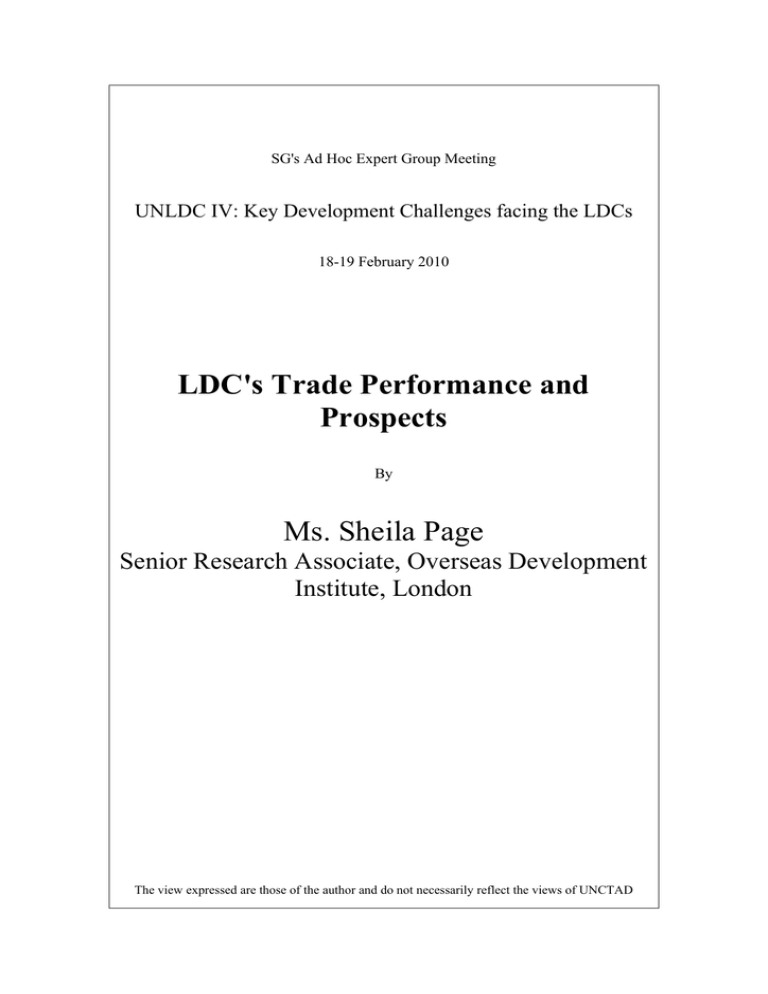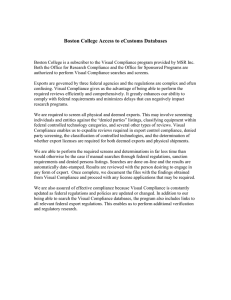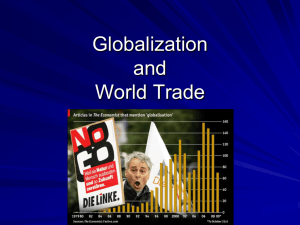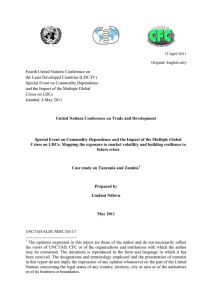LDC's Trade Performance and Prospects Ms. Sheila Page Senior Research Associate, Overseas Development
advertisement

SG's Ad Hoc Expert Group Meeting UNLDC IV: Key Development Challenges facing the LDCs 18-19 February 2010 LDC's Trade Performance and Prospects By Ms. Sheila Page Senior Research Associate, Overseas Development Institute, London The view expressed are those of the author and do not necessarily reflect the views of UNCTAD LDCs’ Trade performance and Prospects Sheila Page UNCTAD 18-19 February 2010 Outline – in 5 parts 1. Importance and implications of new markets. 2. Climate change: opportunities and problems. 3. Impact of the crisis 4. Aid for Trade Capacity Building 5. Market access issues 2 Asian Impact New Markets Changing LDCs’ Comparative advantages ¾ To commodities ¾ Away from manufactures and services 3 Climate Change Examples of Effects Problem Agricultural output and trade reduced Opportunity New income from carbon reduction (e.g. REDD) Policy Opportunity Comparative advantage in low carbon agriculture Policy Problem Policies to promote local consumption 4 The Impact of the Crisis: Trade as Problem and Solution VULNERABILITY = EXPOSURE – RESILIENCE Larger export shares increase exposure But: exports of more goods to more markets increase resilience Impact of crisis depends on whether resilience has increased as much as exposure. 5 Which countries are exposed to crisis through trade? Countries with a significant share of exports to crisis-hit advanced economies; Economies with concentrated exports in a few commodities Countries exporting ‘stockable’ commodities whose prices have dropped or products and services with high income elasticity of demand (eg tourism); Countries heavily dependent on remittances 6 Which countries are likely to be less resilient? “INSURANCE” Countries with a high current account deficit with pressures on exchange rates and inflation rates, Countries with low reserves; Countries with high government deficits and weak fiscal balances; Countries with high external debts; Countries without new markets for their exports “COPING” Countries with weak policy implementation capacity and weak institutions (e.g. state business relations); Countries lacking social protection nets. 7 Trade – different shocks Different types of export shocks Commodity price shock affecting (in ODI study) Zambia, Sudan, DRC (oil, mining), but also Uganda (agricultural prices) Manufacturing volume shock (e.g. garments), affecting Cambodia and now Bangladesh Tourism receipt shock (Cambodia, Zambia, Tanzania) Import shocks (e.g. lower oil prices in Tanzania) Æ Shocks in 2009 are not all because of crisis. From a country policy point of view what matters is that there are shocks, not how the source is defined. 8 Export concentration matters Zambia Copper 68.8% Major export market(s) c USA Hong Kong EU China EU USA EU China EU (Unspecified) Switzerland Ethiopia Coffee, sesame seeds 51.9% EU 34.3% 34.7% 50.0% EU EU 26.1% 21.9% Country Cambodia Garments Main exports a Sudan Petroleum oils Bangladesh Garments DRC Cobalt and copper ores, diamonds Mozambique Aluminium Uganda Coffee, fish, Tanzania Gold, fish, precious metal ores Share of total exportsb 83.2% 89.7% 71.5% 57.4% 58.7% Share of total exports d 49.7% 20.5% 20.2% 78.0% 50.6% 26.8% 39.7% 34.0% 26.7% (46.0%) 44.5% Notes: (a)Determined at HS chapter level, but the descriptions shown are of the predominant export(s) within the chapters identified rather than necessarily of the chapters themselves. (b)Share of the HS chapters into which the main exports in the previous column fall in the most recent three years for which data available: i.e. 2005–7 own data for Bangladesh, Tanzania; 2005–8 (excluding 2007) own data for Sudan; 2006–8 own data for Ethiopia, Mozambique, Uganda, Zambia; 2006–8 mirror data for Cambodia, DRC. (c)Any market accounting for 20% or more of total export value. (d)For the same years as given in note (b), except for Cambodia, for which the share in this column is based on 2002–4 own data. Source: ITC calculations based on UN Comtrade data, obtained from ITC Trade Map (on 05.01.10). 9 Real GDP effects vary (% differences in 2009 IMF forecasts Oct 2009 and Oct 2008) 10 Real GDP effects in Africa (% differences in 2009 IMF forecasts Oct 2009 and Oct 2008) 11 Poverty effects: labour-intensive exports have risks as well as benefits Employment effects: greater in DRC mining, than in Zambia which is capital intensive. Employment effects: greater in Cambodian garments than in Bangladeshi garments. 12 Crisis confirms need for growth enhancing diversification How did Uganda cushion the impact of the crisis: regional trade diversification? Role for regions / EAC? What explains the difference between Bangladesh and Cambodia value of garments exports? Diversification vs. niche marketing? Why do some African countries and East European countries suffer so much? Overdependence on commodities and foreign investment/lending respectively Æ Renewed importance of diversification 13 Aid for Trade Capacity Building More funding available More funding through multilateral agencies More funding for some issues ¾ Trade policy and regulation ¾ Infrastructure ¾ Building productive capacity 14 Implications for donors Promote crisis-resilient growth (shock facilities, ensure appropriate composition of fiscal stimulus, promote domestic resource mobilisation, trade diversification into new sectors and destinations) Prepare countries for new opportunities and costs: New markets Effects of climate change Effects of climate policies Improve aid for private sector 15 Market Access Few opportunities now for preferences Little to expect from Doha Risks of regions 16







